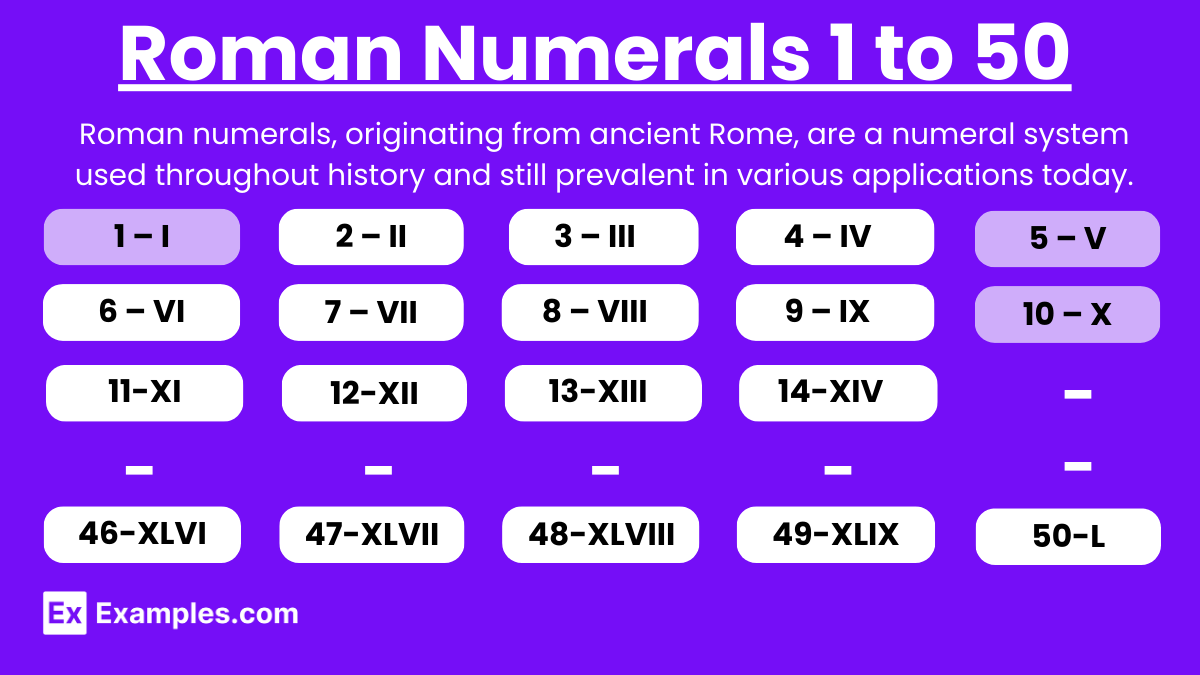What is the Roman numeral for 7?
VII
VI
VIII
IX


Roman numerals, an ancient number system used by the Romans, are still prevalent in various aspects of modern life. The Roman numerals from 1 to 50 are I, II, III, IV, V, VI, VII, VIII, IX, X, XI, XII, XIII, XIV, XV, XVI, XVII, XVIII, XIX, XX, XXI, XXII, XXIII, XXIV, XXV, XXVI, XXVII, XXVIII, XXIX, XXX, XXXI, XXXII, XXXIII, XXXIV, XXXV, XXXVI, XXXVII, XXXVIII, XXXIX, XL, XLI, XLII, XLIII, XLIV, XLV, XLVI, XLVII, XLVIII, XLIX, and L. Understanding these numerals is important for reading historical texts, clocks, and even modern applications like book chapters and movie sequels. Learning Roman numerals 1 to 50 provides a foundation for understanding this ancient numbering system and its continued relevance today.
Download Roman Numerals 1 to 50 in PDF

Download Roman Numerals 1 to 50 in PDF
| 1-I | 26-XXVI |
| 2-II | 27-XXVII |
| 3-III | 28-XXVIII |
| 4-IV | 29-XXIX |
| 5-V | 30-XXX |
| 6-VI | 31-XXXI |
| 7-VII | 32-XXXII |
| 8-VIII | 33-XXXIII |
| 9-IX | 34-XXXIV |
| 10-X | 35-XXXV |
| 11-XI | 36-XXXVI |
| 12-XII | 37-XXXVII |
| 13-XIII | 38-XXXVIII |
| 14-XIV | 39-XXXIX |
| 15-XV | 40-XL |
| 16-XVI | 41-XLI |
| 17-XVII | 42-XLII |
| 18-XVIII | 43-XLIII |
| 19-XIX | 44-XLIV |
| 20-XX | 45-XLV |
| 21-XXI | 46-XLVI |
| 22-XXII | 47-XLVII |
| 23-XXIII | 48-XLVIII |
| 24-XXIV | 49-XLIX |
| 25-XXV | 50-L |
1. Convert 14 to Roman Numerals:
2. Convert 27 to Roman Numerals:
3. Convert 39 to Roman Numerals:
4. Convert 46 to Roman Numerals:
5. Convert 50 to Roman Numerals:
6. Convert XVI to Arabic Numerals:
Understanding Roman numerals from 1 to 50 is essential for interpreting this ancient numerical system, which is still used in various modern contexts. The numerals include I (1), V (5), X (10), L (50), and their combinations such as IV (4), IX (9), XV (15), XX (20), XXX (30), XL (40), and L (50). Mastering these numerals involves learning the rules of repetition, addition, and subtraction, enabling one to form and comprehend numbers like II (2), VII (7), XII (12), and XXXVIII (38). This knowledge enhances numerical literacy and provides historical insight, making it valuable for both academic and everyday applications.
Text prompt
Add Tone
10 Examples of Public speaking
20 Examples of Gas lighting
What is the Roman numeral for 7?
VII
VI
VIII
IX
How is 30 written in Roman numerals?
XX
XXX
XXV
XL
What is the Roman numeral for 16?
XVII
X
XV
XVI
Which Roman numeral represents 22?
XXIII
XX
XXI
XXII
How is 44 written in Roman numerals?
XLIX
LIII
XLIV
XLV
What is the Roman numeral for 39?
XXXIX
XXXVIII
XXXIX
XXXV
How would you write 50 in Roman numerals?
L
XL
LI
XV
Which Roman numeral represents 11?
XI
X
XII
IX
What is the Roman numeral for 28?
XXIX
XXVII
XXVIII
XXX
How is 35 written in Roman numerals?
XXXIV
XXXV
XXXVI
XLV
Before you leave, take our quick quiz to enhance your learning!

